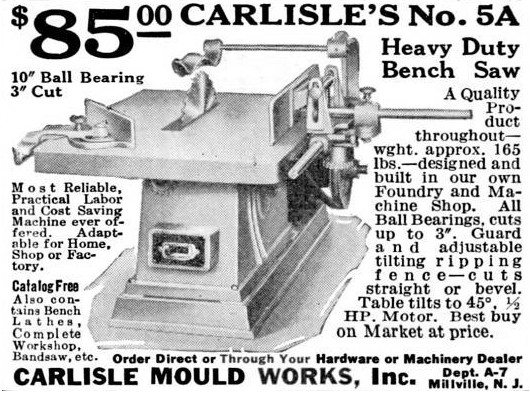 |
| From July 1930 Popular Mechanics |
This firm was in business by 1915, specializing in making cast iron moulds for glass factories. In 1929 they had a short-lived sideline manufacturing a small motorized table saw. Late that year the stock market crashed and triggered a nearly decade-long depression. It appears that the saw disappeared from the market within a year or so of introduction. The company itself survived until at least the mid-1960s.
Information Sources
- A 1915 issue of the American Flint Glass Workers' Union journal, The American Flint, carries this item: "The Carlisle Mould shop, Millville, N. J., wishes a mould maker to do planing, pinning and general work. Applicants should apply to the Carlisle Mould Works..."
- From the 1920-1922 Proceedings of the Consolidated Convention of the American Flint Glass Workers' Union: "Your committee recommends that the expressions contained in the communications of Secretary Higbee, Local Union No. 7, relative to the Carlisle Mould Company, Millville, N. J., be rejected. We further recommend that mould makers shall be required to deposit their cards in the nearest mould making local union, as we believe that it is to the best interests of the ..."
- December 1929 issue of Hardware Age.
Carlisle Combination Saw. The Carlisle "Whirlwind" combination saw has a table top 12 by 16 in. and stands 10 in. high from base to top of table. This table top can be raised and lowered, making a cut up to 2 1/4 in. A 5/8-in. mandrel runs in solid bronze bushings and has a lubrication capacity for 200 to 300 working hours. A 8-in. combination saw blade is standard equipment, together with a 12-in. ripping fence, adjustable mitre cut-off gage, 6-in. sanding disk, 5 in. by 1/2-in emery wheel and a 1/2-hp., 60-cycle motor operating on 110-volt current. Carlisle Mould Works, Millville, N. J.
- Listed in the Merchandise Directory in the 1966-07-21 issue of Hardware Age. This data point is not strong evidence that the company was still in business at that time because these types of directories were slow to delete outdated entries.